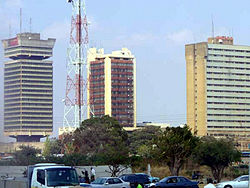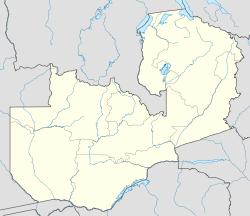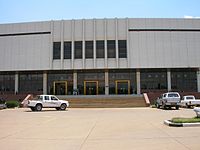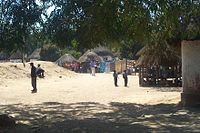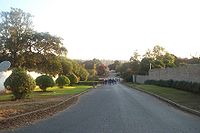
Lusaka
Did you know...
This content from Wikipedia has been selected by SOS Children for suitability in schools around the world. SOS Child sponsorship is cool!
| Lusaka | |
|---|---|
| — City — | |
| View of Lusaka's Central Business District | |
|
|
|
| Coordinates: 15°25′S 28°17′E Coordinates: 15°25′S 28°17′E | |
| Country | Zambia |
| Province | Lusaka Province |
| District | Lusaka District |
| Established | 1905 |
| City status | August 25, 1960 |
| Government | |
| • Mayor of Lusaka | Daniel Chisenga |
| Area | |
| • Total | 360 km2 (140 sq mi) |
| Elevation | 1,300 m (4,265 ft) |
| Population (Oct 2009) | |
| • Total | 3,100, 000 |
| Time zone | SAST ( UTC+2) |
| Area code(s) | (1) |
| Website | http://www.lcc.gov.zm |
Lusaka is the capital and largest city of Zambia. One of the fastest-developing cities in Southern Africa, Lusaka is located in the southern part of the central plateau at an elevation of about 1,300 metres (4,265 feet). As of 2010, the city's population is about 1.7 million. Lusaka is the centre of both commerce and government in Zambia and connects to the country's four main highways heading north, south, east and west. English is the official language of the city, but Nyanja, and Bemba are also common.
Government and administration
As national capital, Lusaka is the seat of the legislative, executive and judicial branches of government, epitomized by the presence of the National Assembly (parliament), the State House (office of the President), and the High Court. The Parliament is situated at the Parliament complex, which features a 15-story building. The city is also the capital of Lusaka Province, the smallest and most populous of the country's nine provinces, and forms an administrative district run by Lusaka City Council. In 2007, the mayor was Steven Chilatu ( PF), and the deputy mayor was Mary Phiri.
List of mayors:
- F. Payne 1954–5
- H.K.Mitchell 1955–6
- Ralph Rich (Zambia)|Ralph Rich 1956–7
- H.F. Tunaley 1957–8
- H.K. Mitchell 1958–60
- Jack Fischer 1960–1
- Richard Sampson 1962–3
- S.H. Chilesh 1964–5
- W. Banda 1965–9
- F. Chirwa 1969–71?
- Dr. Simon C. Mwewa up to 1982
List of Governors (decentralisation – one party participatory era)
- Dr. Simon C. Mwewa 1982 to 1983
- Donald C. Sadoki
- Michael Sata
- Rupiah Banda
- Bautius Kapulu
- Lt. Muyoba – up to 1991
List of Mayors – Multi-Party Era
- John Chilambwe 1993–1994
- Fisho Mwale 1994–1996
- Gilbert R. Zimba Local Government Administrator – 1996–1999
- Patricia Nawa
- Patrick Kangwa
- John Kabungo
- Levy Mkandawire
- Stephen Mposha
- Christine Nakazwe
- Stephen Chilatu
- Robert Chikwelete
- Daniel Chisenga –present
History
Lusaka was the site of a village named after its headman Lusaaka, which, according to history, was located at Manda Hill, near where the Zambia's National Assembly building now stands. In the Nyanja language, Manda means graveyard. The area was expanded by European (mainly British) settlers in 1905 with the building of the railway.
In 1935, due to its fairly central location, its situation on the railway and at the crossroads of the Great North Road and Great East Road, it was chosen to replace Livingstone as the capital of the British colony of Northern Rhodesia.
After the federation of Northern and Southern Rhodesia in 1953, it was a centre of the independence movement amongst some of the educated elite that led to the creation of the Republic of Zambia. In 1964, Lusaka became the capital of the newly independent Zambia.
In recent years, Lusaka has become a popular urban settlement for Zambians and tourists alike. Its central nature and fast growing infrastructure sector have increased donor confidence and as such Zambians are seeing signs of development in the form of job creation, housing, etc. Consequently, it is thought that with proper and effective economic reforms, Lusaka as well as Zambia as a whole will develop considerably. Lusaka is home to a diverse community of foreigners, many of whom work in the aid industry as well as diplomats, representatives of religious organizations and some business people.
Education
Zambia's highest institution of learning the University of Zambia is based in Lusaka. Lusaka has some of the finest schools in Zambia, including the American International School, International School of Lusaka, Rhodes Park School, the Lusaka International Community School, the French International School, the Italian international School, the Lusaka Islamic Cultural and Educational Foundation (LICEF), the Chinese International School, and Baobab College. Rhodes Park School is not an international school, though there is a large presence of Angolans, Nigerians, Congolese, South Africans, and Chinese. The children of the late President, Levy Mwanawasa as well as the children of Vice-President George Kunda, attend the Rhodes Park School.
Points of interest
Attractions include Lusaka National Museum, the Political Museum, the Zintu Community Museum, the Freedom Statue, the Zambian National Assembly, the Agricultural Society Showgrounds (known for their annual agricultural show), the Moore Pottery Factory, the Lusaka Playhouse theatre, a cinema, the Cathedral of the Holy Cross in Lusaka, a cenotaph, a golf club, the Lusaka Central Sports Club, and the zoo and botanical gardens of the Munda Wanga Environmental Park. The city is also home to the University of Zambia. Along Great East Road are the two largest shopping malls in Zambia, Arcades shopping mall (with open-air storefronts) and Manda Hill shopping mall (enclosed shops), which was recently revamped and is home to international stores such as Shoprite, Game and Woolworths, a new movie theatre and boasts of the first KFC in the country.
The city centre includes several blocks west of Cairo Road, around which lie the New City Market and Kamwala Market, a major shopping area, as well as the Zintu Community Museum. Further east lies the government area, including the State House and the various ministries, around the Cathedral Hill and Ridgeway areas. One of the main streets and points of interest upon business is the street of Cairo Road.
According to former mayor Richard Sampson, Cairo Road was named by a local farmer, Albert Dunbar, in about 1923.
Some buildings along Cairo Road are the Findeco House (25 floors), Central Bank Building, Indeco House (19 floors), Zambia National Building Society Headquarters (20 floors), Old Zambia Lotto Head Office, Zambia National Commercial Bank (21 floors), Barclays Bank Zambia Head Office, Stanbic Bank Zambia Headquarters, Investrust Bank (18 floors).
Transport
Airport
The city is home to Kenneth Kaunda International Airport, formerly known as Lusaka International Airport and lies on the railway line from Livingstone to Kitwe. This airport is the hub of Zambezi Airlines. Zambezi airlines offers flights to Johannesburg, Ndola and Dar es Salaam. Lusaka International Airport is used as a public and military airport. There is also an old airport nearer to the centre of the city that is no longer used by civilians, but occasionally used by the president.
Bus
Bus services to towns surrounding Lusaka, such as Siavonga and Chirundu use the Lusaka City Market Bus and the inter-city bus terminus station and the city bus station (Kulima Towers Station).
Sister cities
 Dushanbe, Tajikistan, since 1966
Dushanbe, Tajikistan, since 1966 Los Angeles, United States, since 1968
Los Angeles, United States, since 1968 Izhevsk, Russia.
Izhevsk, Russia.
Notable residents
The rugby union players Corné Krige and George Gregan, who respectively captained the South Africa and Australia teams in both the 2002 and 2003 Tri Nations Series, were coincidentally born in the same hospital in Lusaka. Krige's parents still live in Zambia.
- Amy Holmes (born in 1973 in Lusaka, Zambia) is a news anchor on Glenn Beck's GBTV. She formerly was an independent political contributor for CNN and has appeared on Fox News.
Suburbs
Suburbs around Lusaka include Handsworth Park, Sunningdale, Kabulonga, Woodlands, Jesmondine, Acacia, Northmead, Olympia Park, Roma, Kalundu, Chelston, Avondale, Rhodes Park, Prospect Hill, Longacres, Fairview, Chainama Hills, State Lodge, Makeni, Emmasdale, Leopards Hill, New Kasama, Chalala, Ibex Hill, Mass Media, Libala, Marshlands, Manda Hill, Chainda, Chudleigh, Kamwala South, Kamwala, Mwembeshi, Barlastone, Foxdale, Madras, NIPA, Mapepe, Lilayi, Presidential Housing Initiative (PHI), Nyumba Yanga, Olympia Extension, Thorn Park, Twinpalm, Villa Elizabetha.
Other residential areas and slums are Kabwata (a working class area, home to the Kabwata Cultural Centre), Misisi, Madras, Ziwa Zakho, Shang'ombo, Kwa Shadreck, Matero, Mtendendere, Chaisa, Chawama, John Laing, Kalingalinga, Kwa George, Chipata Compound, Ng'ombe, Lilanda,Chunga, Mandevu, Garden Compound, Bauleni, Helen Kaunda, Kaunda Square (stage one and stage two), and Chilanga (Lusaka), Zambia.
Climate
Primarily due to its high altitude, Lusaka features a humid subtropical climate. Its coldest month, July, has a monthly average temperature of 16°C, a couple of degrees shy of what would constitute a tropical climate, specifically a tropical savanna climate. Lusaka features a relatively warm climate, typically with warm (but not hot) summers and very mild “winters”. The city’s warmest month, October, sees monthly average high temperatures at around 32°C. Lusaka features a wet season and a dry season with the dry season predominating the year, lasting from October through April.
| Climate data for Lusaka | |||||||||||||
|---|---|---|---|---|---|---|---|---|---|---|---|---|---|
| Month | Jan | Feb | Mar | Apr | May | Jun | Jul | Aug | Sep | Oct | Nov | Dec | Year |
| Record high °C (°F) | 39.6 (103.3) |
36.4 (97.5) |
33.6 (92.5) |
33.0 (91.4) |
32.0 (89.6) |
29.9 (85.8) |
29.7 (85.5) |
33.5 (92.3) |
38.5 (101.3) |
37.2 (99) |
38.6 (101.5) |
33.9 (93) |
39.6 (103.3) |
| Average high °C (°F) | 27.4 (81.3) |
27.4 (81.3) |
27.5 (81.5) |
27.1 (80.8) |
25.8 (78.4) |
23.8 (74.8) |
24.0 (75.2) |
26.5 (79.7) |
30.3 (86.5) |
31.7 (89.1) |
30.4 (86.7) |
27.7 (81.9) |
27.5 (81.5) |
| Daily mean °C (°F) | 21.5 (70.7) |
21.5 (70.7) |
21.1 (70) |
19.9 (67.8) |
17.4 (63.3) |
15.2 (59.4) |
14.9 (58.8) |
17.3 (63.1) |
21.3 (70.3) |
23.5 (74.3) |
23.4 (74.1) |
21.7 (71.1) |
19.9 (67.8) |
| Average low °C (°F) | 17.6 (63.7) |
17.4 (63.3) |
16.4 (61.5) |
14.0 (57.2) |
10.7 (51.3) |
7.8 (46) |
7.2 (45) |
9.2 (48.6) |
12.9 (55.2) |
16.2 (61.2) |
17.4 (63.3) |
17.8 (64) |
13.7 (56.7) |
| Record low °C (°F) | 13.0 (55.4) |
12.9 (55.2) |
10.0 (50) |
8.0 (46.4) |
5.4 (41.7) |
0.2 (32.4) |
0.7 (33.3) |
2.8 (37) |
5.8 (42.4) |
9.0 (48.2) |
10.8 (51.4) |
10.4 (50.7) |
0.2 (32.4) |
| Precipitation mm (inches) | 245.4 (9.661) |
185.9 (7.319) |
95.0 (3.74) |
34.7 (1.366) |
3.1 (0.122) |
0.0 (0) |
0.1 (0.004) |
0.4 (0.016) |
1.7 (0.067) |
18.4 (0.724) |
89.3 (3.516) |
208.1 (8.193) |
882.1 (34.728) |
| Avg. precipitation days (≥ 1.0 mm) | 18 | 15 | 10 | 3 | 0 | 0 | 0 | 0 | 0 | 2 | 8 | 16 | 72 |
| % humidity | 82.3 | 82.5 | 80.7 | 75.8 | 69.3 | 65.2 | 61.1 | 53.6 | 46.3 | 48.6 | 60.2 | 78.6 | 67.0 |
| Mean monthly sunshine hours | 176.7 | 168.0 | 220.1 | 246.0 | 275.9 | 270.0 | 294.5 | 303.8 | 291.0 | 272.8 | 234.0 | 182.9 | 2,935.7 |
| Source: NOAA | |||||||||||||

